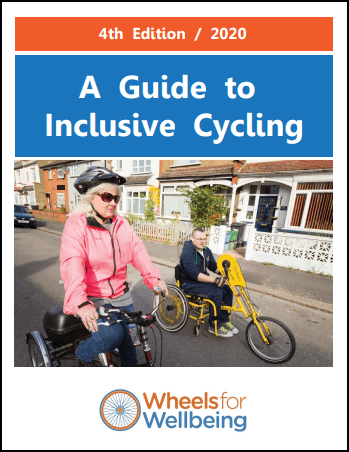As 2020 comes to an end, we explain how Christmas came very early for us at Wheels for Wellbeing this year and yet how much work remains for us to do.

This week we unveil the latest edition of our Guide to Inclusive Cycling. Now in its fourth edition, the guide was first published in 2017 to bring together our experience and expertise of all things inclusive cycling. While the fourth edition builds upon the work of the previous three, the circumstances during which it has been published mark the achievement of a significant milestone for the charity and our stakeholders.
2020 and the start of the new decade has been extraordinary in many ways. While the COVID-19 pandemic has encouraged governments to prioritise cycling over other modes, a slow but steady shift towards providing more inclusive cycling infrastructure here in the UK was already underway. We are delighted to say that Wheels for Wellbeing had positively contributed towards this shift, and it speaks volumes about the progress we’ve made as a charity that the ideas encapsulated in our Guide to Inclusive Cycling have directly influenced government policy.
Before we say more about what has changed, we will take this opportunity to reflect on how we got here: in 2017 we contributed to the UK government’s consultation on its Accessibility Action Plan, which up to that point made no mention of cycling as a transport mode worthy of accessibility considerations. In 2018, two commitments relating to cycling were included in the government’s first Inclusive Transport Strategy. We considered this a huge win! The first of these two commitments was that accessibility for Disabled people as cyclists would be considered as part of the planned update for the ten-year-old technical guidance for cycling (Local Transport Note 02/08), and was to be published in early 2019.
During the autumn of 2018, we were invited to be members of the Department for Transport’s expert steering group to review LTN02/08. We took part in detailed discussions, spent the Christmas break poring over and commenting on drafts, and helped produce inclusive photographs for use in the guidance document. We were very curious to find out how many of our, frankly, quite radical recommendations might make it into the final edit (such as no longer talking about “bicycles” but using the word “cycles” instead, or no longer building cycling infrastructure based on the measurements of the bicycle but on the concept of the “cycle design vehicle” – which encompasses the most common types of non-standard cycles).
In July 2020, alongside Gear Change (a “Bold Vision for Cycling and Walking”) the government finally published the long-awaited Local Transport Note (LTN) 1/20. Not only had “cycles” and the “cycle design vehicle” made the edit, but the minister’s foreword stated that “inclusive cycling is an underlying theme throughout [the guidance] so that people cycling of all ages and abilities are considered”. The introduction made clear that “the Equality Act 2010 requires public sector authorities to comply with the Public Sector Equality Duty in carrying out their functions”, that “access control measures, such as chicane barriers and dismount signs, should not be used” and even that “for many people, a cycle is a mobility aid that helps them get around or carry items or passengers”. All these are central themes of our Guide to Inclusive Cycling! For us, Christmas had come very early indeed. We felt we had been listened to and whatever happens from here, we had affected significant change.
However, this amazing milestone also rendered our Guide out of date as many of the reference documents it had been pointing to had been replaced by LTN 1/20. We teamed up with city transport think tank Fare City to help us with this latest update (which has had a graphic redesign to improve legibility and brand consistency and now includes direct hyperlinks to key parts of LTN 1/20). Fare City interviewed our Director, Isabelle Clement, as part of their Street Side Talks podcasts series (which is recommended listening) and they also helped us reflect on what the future of inclusive cycling may look like and how this can be catered for in future editions of the guide. For example, we will be wanting to learn more and advocate better about the barriers faced by people cycling with mental health issues, autism and hearing impairments, to name but a few. The format of the guide will likely need to become even more accessible, modular, searchable, etc.
And of course, we will need to continue to lobby for change. For instance, we are still waiting to hear from the Department for Transport about the second commitment in their 2018 Inclusive Transport Strategy, i.e. to “explore the feasibility of amending legislation to recognise the use of cycles as a mobility aid in order to increase the number of Disabled people cycling by 2020”. The huge cost of cycle ownership for riders of non-standard cycles has also yet to be addressed. Finally, LTN 1/20 is a guidance document as opposed to a set of national standards, meaning that there is no guarantee its contents will be adhered to as they are not mandatory.
This fourth edition of the Guide to Inclusive Cycling marks an important milestone for us and our stakeholders. Yet we pledge to keep pressing for more of its recommendations to be adopted and to keep developing it so that future editions continue to show the way to full cycling equality for Disabled people.
You can access the fourth edition of our Guide to Inclusive Cycling by clicking here.
